Mar 9, 2021
Boat Lift Common Mistakes
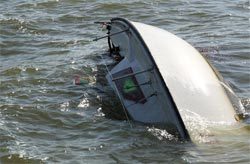
My boat lift cable broke…and I can’t get
No one wants to see this.
Imagine losing your boat even before getting it out on the water. Embarrassing – to say the least.
To keep you and your boat safe, Pier & Waterfront Solutions has some tips to avoid boat lift mistakes.
Failure to follow the manufacturer’s instructions means you’re more liking looking at a boat – IN the water, instead of – ON the water.
Never Exceed the Weight Capacity
It seems obvious, yet this happens every year. Extensive testing goes into ensuring a lift can support a calculated weight. Never ignore the results of those tests.
Engineers use a balanced load to determine the lift capacity of each unit. BOTH the weight and the load distribution are equally important to the safety of your boat lift.
Never assume a lift can support “a few extra pounds.” If the salesperson tries to sell you a lift rated for even a pound less than your boat and accessories weight, – find a different seller.
At PWS, we have the proper lift for all types of watercraft.
Give yourself plenty of wiggle room. Assume your boat weighs a couple of hundred pounds more than what even the manufacturer indicates. Then, add the extras. More on this later.
Why? It is not unusual to find several different weights listed for the same boat. Are you willing to chance the lowest listing?
The listed weight refers to the maximum weight of the craft plus all the extras.
Boaters also need to account for fuel, equipment, and anything else that will add weight to the boat.
Equally important – Properly Position the Boat.
Like a canoe in the water, balance is essential.
With a lift rating, manufacturers assume that you will balance the beams’ load when you put the boat on the lift. Only you have control over this.
On a boat lift, the boat should be equally balanced on the front and back beams. The left and right sides also should be centered. If the boat is balanced correctly, you should not be able to raise the bow at all with your hands.
A boat set too far back on the lift beams creates a light front. It’s much like the imbalance of a 100 -pound kid on one end of a seesaw with a 30 -pound kid on the other end. Waves can easily wash up beneath the front and work the boat off the lift.
At the same time, too much weight on one beam also creates extra strain on the cables. If the cables aren’t in perfect shape, they could break.
Something to consider
There are cables in each of the four corners holding your boat up. These cables distribute the weight of the boat equally to the four corners. That statement assumes you distribute the boat’s weight evenly on the rack beams in all four directions.
Assume you would like the boat sitting closer to the dock to make it easier to enter your boat. If you move the boat closer to the side of the lift frames (off-center), you are putting extra weight on the cables closest to you.
Now, put the boat a foot back on the beams.
You have not only put more weight on the two cables nearest the dock, but you have also added more weight to one cable at the “entrance” or back of the boat.
Now, add in a weakened cable, and you can see what’s coming next. Don’t let this happen to you. (Need a reminder- Look at the first image)
Load your equipment carefully.
Although you should load the boat after it’s in the water if you choose to load it before lowering the boat, distribute the load evenly.
Be Aware of Lifting Height
Please do not continue to raise the boat once it reaches the top. It seems simple enough. But wait, there’s a storm coming, and I have 1/2″ clearance between the rack and the top beam. Isn’t it best to close that gap?
Continuing to crank the winch places stress on all the parts, including the beams and possibly damaged cables. Here’s what could happen – see above.
We see this situation all the time.
Raising the boat too far may cause damage to any one of the lifting components. Some lifts automatically shut off when the lift reaches its maximum height (Hydraulic). Make sure this mechanism works as part of the lift’s routine maintenance.
Proper Loading
It may seem straightforward to load a boat while it is not rocking on the waves. However, anything loaded before lowering the boat into the water brings you closer to the lift’s maximum rating.
Loading the boat on the water helps you determine where the best weight distribution to maintain watercraft balance is.
We recommend that you lower the vessel before adding any heavy equipment or other essentials.
If your lift isn’t functioning correctly, it may be time to get a new ShoreMaster boat lift.
PWS will be happy to help you decide which lift is best for your location and type of watercraft. By talking to PWS, you can avoid making costly lift mistakes.
Want more information on this topic? Follow this link. Easier still – give the boat information to PWS. Let us do the calculations for you.
Where is Pier & Waterfront Solutions?
Pier & Waterfront Solutions, 7325 St. Hwy 57, is located 3 miles south of Sturgeon Bay. Go 1 mile PAST the intersection with County road MM (heading north). Look on the right at the next intersection – Idlewild Road and Hwy 57.
ARE WE OPEN?
Pier & Waterfront Solutions remains “open” year-round.
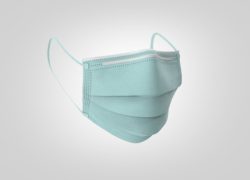
Please use face masks.
The virus continues to spread. PWS is conducting as much business as possible by email, text, or phone.
Site visits continue as usual. When making in-person contacts, we follow “social distancing” guidelines whenever possible.
Our display yard is OPEN 24-7
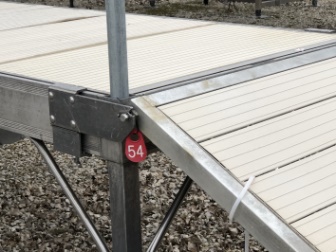
Red Tag
PWS‘s display area is always open for you to examine at your leisure. All displays available for sale have a numbered, red tag on them. Want more information on something you saw in our yard? Please reference that number when you inquire.
PWS will provide estimates by email to make the process faster, safer, and paperless.
Call, message, or email us with any questions.
Thank you for allowing us to work with you.
Feb 2, 2021
Top Signs You Need a New Dock
Time for a new Dock? Piers and docks that are more than ten years old may show some signs of wear or damage. Without proper maintenance, your dock system may not look or perform properly. Remember, it is possible to repair minor damage at a reasonable cost.
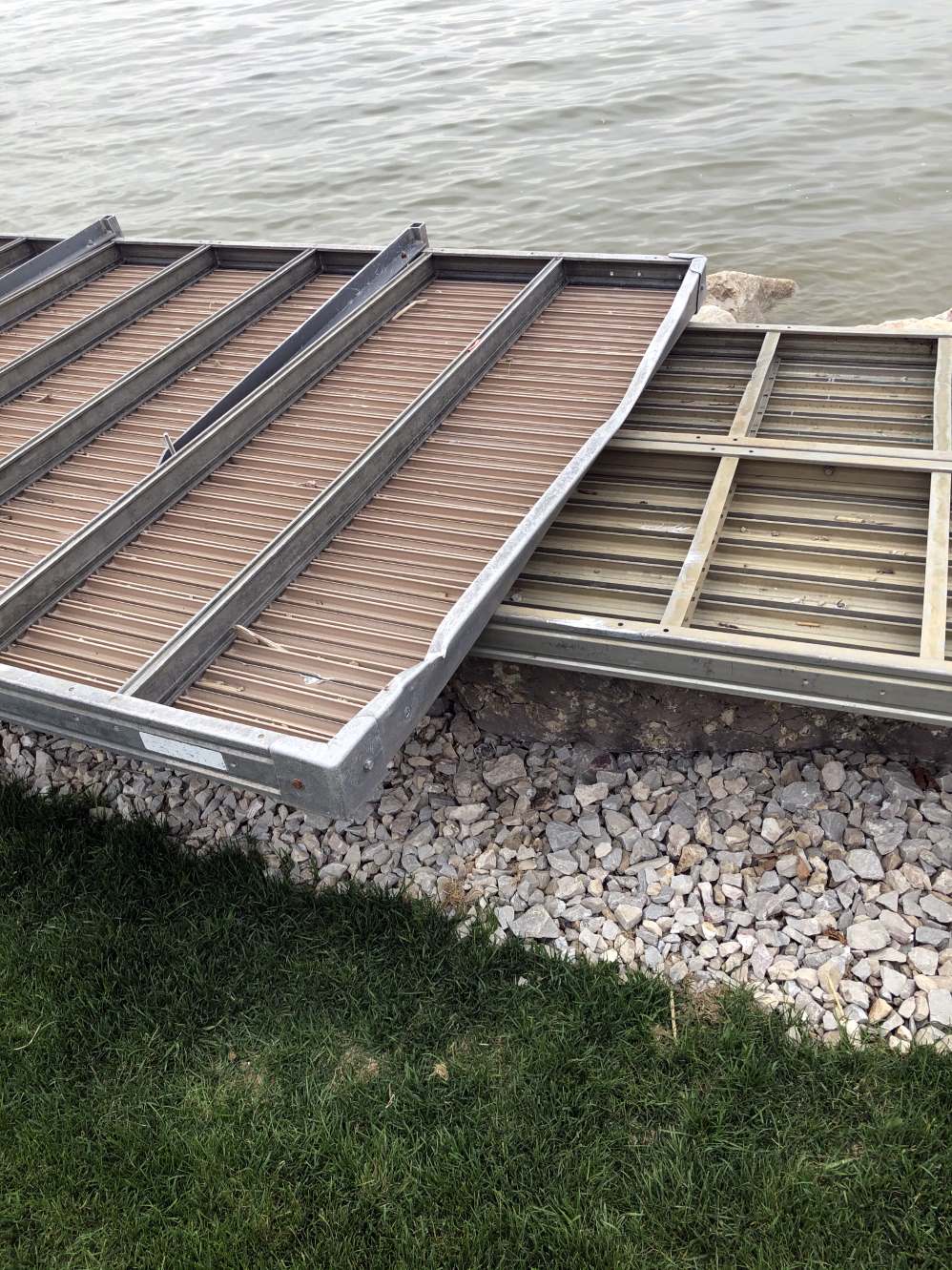
New Dock Needed
Be sure to contact Pier & Waterfront Solutions for an inspection if you have damage and you aren’t sure what repairs to make.
If your dock is getting dangerous, unsteady, replacement may be the only option.
Here are the five signs that you should think about when investing in a brand new pier.
Widespread Rust
Some metals exposed to water will rust. Small amounts of rust can be an easy fix. If possible, replace or repair an individual part before it gets out of control.
Larger rust areas could spread, which can lead to structural failure in the future. In cases like these, a completely new pier might be necessary.
Aluminum docks made of durable, rustproof metal are more resistant to rust than others. Aluminum is an option when considering upgrading or replacing a failing wood dock.
Wood Rot
Wooden docks can rot when the water has been allowed to seep in. Moss, mildew, algae, and other growth can trap moisture in a wood dock, worsening the problem. You can solve or prevent this problem by keeping your pier clean and well maintained.
If the damage involves minor areas, replace the components with new, treated lumber. But, when several locations are rotting, it’s time to replace your dock.
Consider replacing a wooden dock with different materials. Those materials include aluminum painted to look like wood. These are some of the premium ShoreMaster decking options.
Cracking or Warping Dock Supports
Certain support materials can become cracked or warped thanks to pressure from waves.
Accidents can also happen. If a boat or a large floating object hits the pier, cracks may appear on the legs or structural components. PWS can make the repairs.
But, stay safe, replace the entire structure when significant damage occurs. If the damage involves the legs or critical structural components, it may be time to replace the whole section or structure.
Tip: Prevent damage from boat collisions – install bumpers on the perimeter of your pier.
Damaged Foundation
Permanent docks sit on posts that support the pier. Assessing the damage below the waterline is difficult. Repairing it requires specialized equipment. PWS can help.
Pier foundations are subject to shifts causing severe damage. Any cracking is a sign that further investigation and possibly replacement is necessary.
Contact Pier & Waterfront Solutions for an inspection.
Can’t Secure the legs Properly?
Permanent dock systems have supports to hold them up. Supports are driven into the ground until it hits a stable area for stability. In some cases, depths reached can be as much as 100 feet.
A floating pier might be a good option if you do not encounter large waves. The advantage of a floating dock is that it compensates for changing water levels as they occur.
In some cases, a floating dock can remain in the water throughout the winter months IF there is no ice movement. The pier may be released from its shore anchor points in small harbors, moved into deeper water, and tied off. The pier is allowed to float with any minor ice movement, but it stays secured until spring.
Custom Boat Docking Systems by PWS.
If it’s time to replace or upgrade your boat docking system, PWS can help.
PWS has helped many shoreline owners find their perfect dock and boat lift solution.
Need a repair, a completely new pier or boat lift system, or the ideal accessory? PWS‘s customer support team can help.
Contact Pier & Waterfront Solutions for more information. We know what works best for your area.
Where is Pier & Waterfront Solutions?
PWS, 7325 St. Hwy 57, is 3 miles south of Sturgeon Bay and 1 mile PAST County road MM’s intersection (heading north). Look on the right at the intersection of Idlewild Road and Hwy 57.
ARE WE OPEN?
Pier & Waterfront Solutions remains “open” year-round.

Please use face masks
The virus continues to spread. PWS is conducting as much business as possible by email, text, or phone.
Site visits continue as usual. When making in-person contacts, we follow “social distancing” guidelines whenever possible.
Our display yard is OPEN 24-7

Red Tag
PWS‘s display area is always open for you to examine at your leisure. All displays available for sale have a numbered, red tag on them. Want more information on something you saw in our yard? Please reference that number when you inquire.
PWS provides estimates and quotes by email to make the process faster, safer, and paperless.
Call, message, or email us with any questions.
Thank you for allowing us to work with you safely.
Let’s all stay safe!
Jan 12, 2021
Why are Welded Boat Lift Frames Superior?
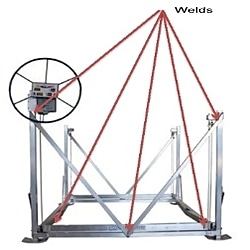
Welds on Vertical Lift Frames
Welded boat lift frames are superior to the typical bolt-together structures found so frequently. There are several reasons for this.
Most of them center around the reduced maintenance, superior strength, and durability of welded lifts and canopy frames.
You spent good money when you bought the boat lift or canopy. Shouldn’t you get the best one available?
Why would you want to spend a weekend checking and tightening the nuts and bolts on your boat lift or canopy? We’re pretty sure you don’t.
In that case, why not purchase a high-quality boat lift or canopy, which has most of its critical components welded together.
ShoreMaster welded boat lift frames and canopies leave you free to enjoy your time away. Why waste any time tightening nuts and bolts. Your time is too valuable.
Quality starts with state-of-the-art welding.
Welded Frames = Less Maintenance
ShoreMaster welded boat lifts save you time because they require less maintenance and give you more strength.
Welded Boat Lift Frames Stay True and Square
Bolt-together boat lifts eventually become loose due to everyday use and prolonged periods of heavy waves striking the frame. Corrosion of the hardware only accelerates this process.
If you neglect to tighten a loose bolt on your boat lift, other parts of the boat lift such as the cables, pulleys, winch, or other components can wear prematurely.
A loose bolt will result in the frame shifting, which may result in a costly repair.
Loose bolts make it extremely difficult for you to discover the source of the failure.
How do you know when you have loose bolts?
A simple test is to push on one corner of the bat lift. If there is excessive movement in the frames, in particular forward and backward, you have one of two situations:
- One of more bolts are loose; or
- The lift is not sitting firmly on the bottom.
What about a canopy frame?
A welded boat lift canopy frame can save you hours in assembly time. Using just five bolts for a welded frame vs. dozens of nuts and bolts makes sense. A welded canopy frame adds more strength and rigidity to the entire boat lift also.
When it comes to assembling a boat lift, or canopy, you’ll be glad that you choose a welded product over a bolt together product.
Also, welded products take less time to assemble than a bolt together product.
Consider for a moment just one person can complete the assembly of a ShoreMaster canopy frame in as little as 30 minutes because the canopy frame includes only four all-welded components; two canopy ends and two canopy sides. Other manufacturers have dozens of parts that need bolting together.
ShoreMaster welded boat lifts do not require replacing frame parts caused by unusual wear due to loose, missing, or corroded welds. A bolt-together frame cannot say the same thing. ShoreMaster adds thick reinforcing plates on the frame structure when using bolts structure.
A Welded Boat Lift Offers Higher Resale Value
Because welds are permanent and require no maintenance, you will find that your welded-together boat lifts are more valuable at resale time. Welds will not rust or corrode like hardware. Potential buyers will be wary of the impending costs to replace worn out or corroded hardware.
Where is Pier & Waterfront Solutions?
Located at 7325 St. Hwy 57, it’s 3 miles south of Sturgeon Bay and 1 mile PAST, Cty MM’s intersection (heading north). Look on the right at the intersection of Idlewild Road and Hwy 57.
ARE WE OPEN?
Pier & Waterfront Solutions remains “open” year-round.

Please use face masks
The virus continues to spread. PWS is conducting as much business as possible by email, text, or phone.
Site visits continue as usual. When in-person contacts are necessary, we follow “social distancing” guidelines as closely as possible.
Our display yard is OPEN 24-7

Red Tag
PWS‘s display area is always open for you to examine at your leisure. All displays available for sale have a numbered, red tag on them. If you want more information or pricing, please reference that number when you inquire.
We provide estimates and quotes by email to make the process faster, safer, and paperless.
What can YOU do?
Please conduct as much business as possible via emails, messaging, and phones. When you see our staff and crews on-site, please practice “social distancing.”
Call, message, or email us with any questions.
Thank you for allowing us to work with you safely.
Let’s all stay safe!
Jan 5, 2021
Boat Lift Styles
In Wisconsin waters, there are (5) different boat lift styles generally used. The (5) styles include:
- Cantilever,
- Vertical,
- Hydraulic,
- Floating, and
- Elevator boat lifts.
Different conditions require different boat lifts.
Cantilever Lift
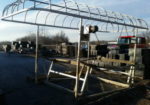
Cantilever Boat Lift Style
If you are on an inland lake or river where the water depth does not fluctuate more than 12″ throughout the boating season and wave action does not exceed 6″, a cantilever lift is generally suitable for you.
Cantilever lifts requires about 12″ of water plus the draft of your boat to operate. The lifting rack requires that depth of water due to the shape of the frames.
At first glance, that seems deep enough for most boats, but you still have to allow enough water above the rack to float your boat.
The real limitation of a cantilever lift is the total lifting height. If a river rises, especially after a heavy rainstorm, a boat can easily float off the lift. The boat is not up high enough to prevent the water from washing it away. Who knows how far it will travel before it hits something?
The normal lifting range is between 40″ and 48″. Remember, the rack starts at 12″ plus the draft of your boat, so you are usually less than 12″ above the water at its highest point.
Vertical Lift
On any large body of water, a vertical lift is the recommended lift for most people. Vertical lifts do a better job of protecting your boat from waves.
Some vertical lifts require about 6″-10″ of water plus the draft of the boat. As an example, ShoreMaster vertical boat lifts require only 6″ of water (plus the draft of your boat). Given the same conditions, you have already gained 6″ with this one feature alone.
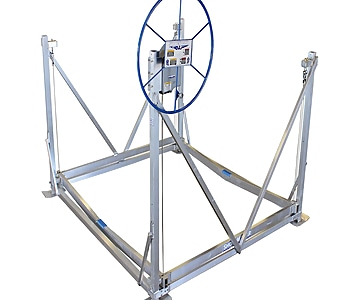
Vertical Boat Lift Style
Now, add the total lifting height of 66″ for a ShoreMaster vertical lift, and you gained a minimum of 18 or more inches of protection vs. a cantilever lift.
Your most significant protection comes from the lifting height. Don’t forget about the strength of the lift frame and the gauge of the material used. ONLY the ShoreMaster boat lift has welded side frames with heavy-duty square or rectangular frames for more strength.
Other brands require several packages of bolts and nuts to assemble the frames. Eventually, the holes for the bolts enlarge, and the frames begin to sway. The solid welded frame is a real advantage at this time. A minimal number of bolts are needed.
Can a lift raise a boat TOO high?
Strange as it may seem, it is possible to go too high. How? When the frames are not strong enough to handle the leverage of the weight from the boat.
At least one brand does lift higher than a ShoreMaster lift, but they failed to use welded frames for the additional strength it needs.
If you can imagine the forces acting against the frames in a storm when you have thousands of pounds suspended in the air with only simple bolts to hold them together. The higher the boat is, the greater the leverage on the frames.
Their leg wall thickness is not heavy enough to handle the forces acting against it. Green Bay produces more than 4′ high waves, and the waves frequently strike against the bottom of a boat, adding to the leverage problems.
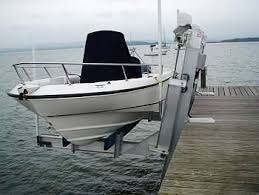
Elevator Boat Lift Style
Elevator Lift
Used with permanent pier installations, Elevator Lifts are a great combination. They raise the boat from the side, making access to the lift very easy.
Narrow channels and areas experiencing large fluctuations in water depth or hurricanes require elevator lifts.
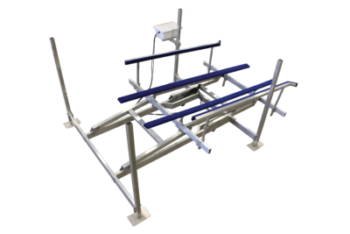
Hydraulic Boat Lifts Style
Hydraulic Boat Lift
A hydraulic lift generally lifts the highest – up to 6′ high in some cases. This height, along with the wide stance of the base, gives excellent protection for your boat. The hydraulic lift handles high waves and water surges during storms also.
These D.C. operated units are:
- Quiet:
- Smooth operating;
- Solar-powered;
- Wireless remote-controlled (There are no wheels to contend with.)
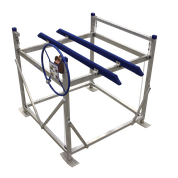
Vertical PWC Boat Lift
Vertical PWC Lift
Jet Ski lifts come in 3 styles: Vertical, Cantilever, and Floating.
The vertical PWC lifts allow you to get into shallow water and raise your boat higher than the cantilever type. They operate in the same fashion as a standard vertical boat lift and provide more protection for your PWC.
The PWC cantilever lift works fine on small lakes and rivers that do not fluctuate in depth or have high waves.
SHOREPORT
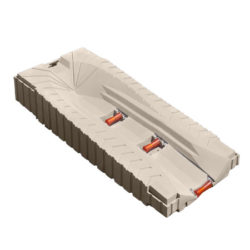
ShorePort PWC Boat Lift Style
The floating lifts (ShorePort) are excellent on rivers that fluctuate a lot in depth or inland lakes. These are very simple to use and require very little water to operate. The floating lift has no maintenance and you simply drive up onto the floating unit. No wheel cranking involved.
Wave action above 12” is not recommended for this type of “lift”. Combine a floating dock with the PWC floating lift and you have the perfect combination for a lake or river that fluctuates during the season but does not have large wave action.
Caution – when using any PWC lift – If you have a sand or small rock bottom near the shore use caution when approaching the lift. Sand and small stones can be sucked into the intake and destroy your motor.
For more information see also: www.wisconsinpws.com/boat-lift-size-correct-one/ and https://wisconsinpws.com/boat-lift-selection/
Where is Pier & Waterfront Solutions?
Located at 7325 St. Hwy 57, it’s 3 miles south of Sturgeon Bay and 1 mile PAST the intersection of Cty MM (heading north). Look on the right at the intersection of Idlewild Road and Hwy 57.
ARE WE OPEN?

Please use face masks
Pier & Waterfront Solutions remains “open” year-round.
The virus continues to spread. PWS is conducting as much business as possible by email, text, or phone.
Site visits continue as usual. When in-person contacts are necessary, we follow “social distancing” guidelines as closely as possible.
Our display yard is OPEN 24-7

Red Tag
PWS‘s display yard is always open for you to examine at your leisure. All displays available for sale have a numbered, red tag on them. If you want more information or pricing, please reference that number when you inquire.
We provide estimates and quotes by email to make the process faster, safer, and paperless.
What can YOU do?
Please conduct as much business as possible via emails, messaging, and phones. When you see our staff and crews on-site, please practice “social distancing.”
Call, message, or email us with any questions.
Thank you for allowing us to work with you safely.
Let’s all stay safe!
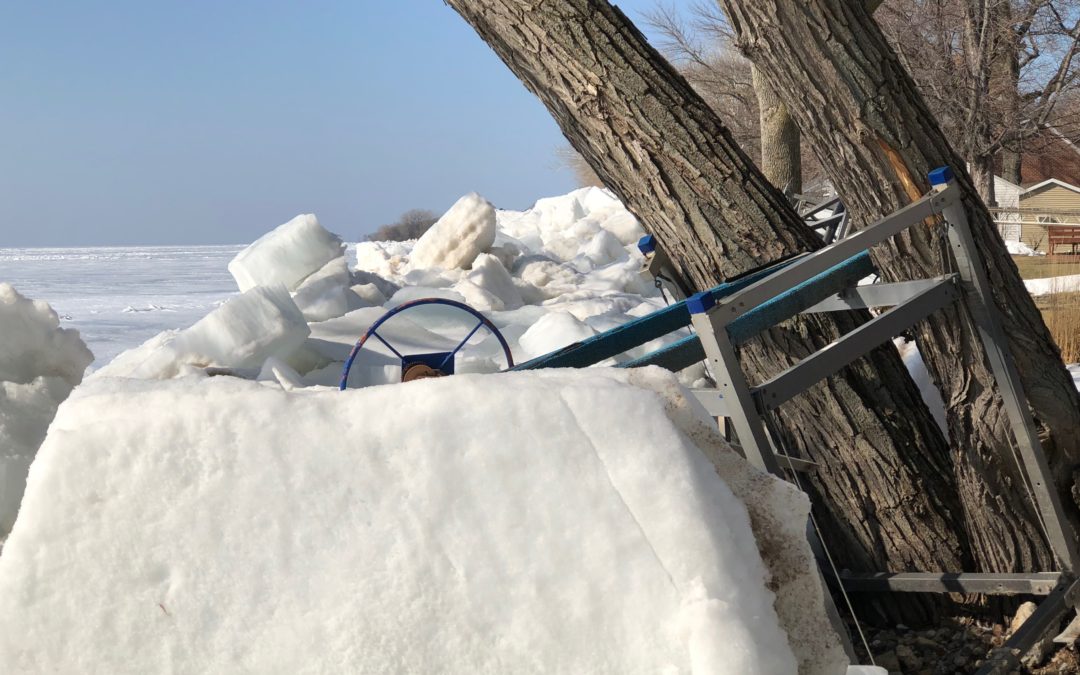
Nov 24, 2020
Should Floating Piers be removed in winter?
Winter can be brutal in Wisconsin. It’s already knocking on the door. What should you do with your floating dock in winter? Will I lose my investment? Should I remove it or leave it in place? Will it get damaged if I leave it in the water? These are all excellent questions.
What should you do with your floating dock in winter?
It depends! It depends on several things. Are you on a pond or in an enclosed area with no ice movement? Then your dock has a chance to survive.
During the winter, there should not be any problem with dock damage. Most people don’t realize this, but there is NO ice under your floats. If you could reach through the ice and put your hand under the float, you would find open water.
The dock is floating on a bed of water throughout the winter. Yes, there is ice all around the sides and under the pier but not under the floats. If the ice does try to squeeze the sides, the floats will push up higher.
Can floating docks survive in winter?
Yes, if certain conditions exist.
Condition 1 and the essential requirement is: There can be NO ice movement in spring. If the ice moves in spring, there is no way to stop damage. You will most likely lose your investment – even on a small pond. Has the ice ever piled up on the shore?
There is one exception to this rule.
On a pond or in a tightly enclosed area where the ice does not pile up, you can leave it in the water. You must, however, remove anything that holds the pier in a firm location. We recommend that before the area freezes over, you move the dock into the center of the pond and loosely tie ropes to keep it there.
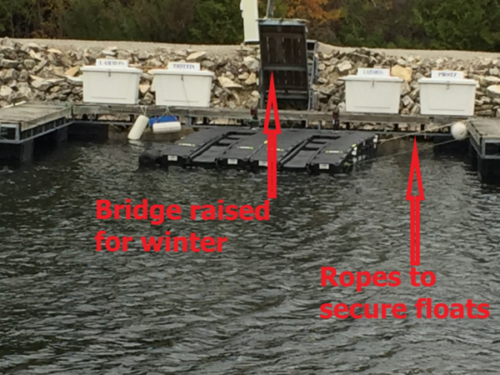
Floating Lift stored for winter
By tying the dock off the shore, the pier will move along with it in the winter and early spring. Moving the pier or raft to the center will save your dock from severe damage. 99% of the time, when the dock finally reaches the shore, the ice has melted away.
Condition 2. Waves should not exceed 1 foot. Remember, the dock in the pond’s center is loosely tied, and you don’t want the dock being torn loose.
Condition 3. Remove any “canopy-like” structures, so they do not allow the wind to move the dock.
Condition 4. Do not allow any of the floats to drag on the bottom at the shore. Allowing any floats to contact the shoreline or sit on rocks could destroy the float and dock.
Condition 5. Remove ladders or any other accessories from the water. Do not allow anything to hand down in the water during the winter.
CONCLUSION
Should I remove it or leave it in during the winter?
Follow these conditions, and in most cases, you will be OK.
Where is Pier & Waterfront Solutions?
Located at 7325 St. Hwy 57, it’s 3 miles south of Sturgeon Bay and 1 mile past the intersection of Cty MM (heading north). Look on the right at the intersection of Idlewild Road and Hwy 57.
ARE WE OPEN?
Pier & Waterfront Solutions remains “open.”
We have implemented measures to ensure the safety of our employees and visitors. At the same time, we are working to maintain the trusted service you expect.

Please use face masks
Because the virus has increased its spread, PWS is conducting as much business as possible by email, text, or phone.
Site visits continue as usual. When in-person contacts are necessary, we follow “social distancing” guidelines as closely as possible.
We provide estimates and quotes by email to make the process paperless, faster, and safer. We hope everyone will stay safe with these measures, and we will be back to normal operations soon.
Our display yard is always open for you to examine at your leisure. All displays available for sale have a numbered, red tag on them. If you want more information or pricing, please reference that number when you call.
We provide estimates and quotes by email to make the process paperless, faster, and safer. We hope everyone will stay safe with these measures, and we will be back to normal operations soon.
What can YOU do?
Please conduct as much business as possible via emails, messaging, and emails. When you see our crews on-site, please practice “social distancing.”
Call, message, or email us with any questions.
Thank you for allowing us to work with you safely.
Let’s all stay safe!


















